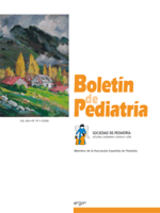Rotavirus G9 es la principal causa de diarrea aguda en niños ingresados menores de 5 años
J.M. Marugán de Miguelsanz , M.I. Fernández-Natal , C. Iglesias Blázquez , H. Rodríguez Pollán , C. Carbayo Lázaro , M. Rosón Varas , M. Neira Arcilla , A. Sánchez-Fauquier
Bol. Pediatr. 2006; 46 (197): 204 - 209
Objetivos: analizar el perfil etiológico de la diarrea aguda en niños ingresados menores de 5 años, y la distribución de los serotipos de rotavirus en nuestro medio. Métodos: estudio prospectivo observacional descriptivo llevado a cabo en todos los niños de 1 mes a 5 años de edad, ingresados por diarrea aguda en el Servicio de Pediatría del Hospital de León, entre 15 de enero y 31 de diciembre de 2005. En todos los casos se realizó coprocultivo para bacterias enteropatógenas, y estudio de virus en heces por inmunocromatografía para rotavirus y adenovirus, y enzimoinmunoensayo para astrovirus, y posteriormente por reacción en cadena de la polimerasa a tiempo real (RT-PCR) para rotavirus, analizando con esta última los genotipos G del mismo. Idéntico estudio se llevó a cabo en los casos de diarrea nosocomial. Resultados: en el período estudiado hubo un total de 1.037 ingresos (excluída la edad neonatal), de los cuales 674 (65%) fueron menores de 5 años. Se incluyeron en el estudio 106 niños: 90 ingresados por diarrea aguda comunitaria (13,3 % de los ingresos en ese grupo de edad), y 16 casos de diarrea nosocomial. En el primer grupo se aisló un patógeno bacteriano en un 13,3% (Campylobacter y Salmonella a partes iguales), y en el 43,3% un virus (rotavirus 87,1%, astrovirus 17,9%, y adenovirus 5,1%), con algunos casos de coinfección. Rotavirus se aisló por tanto en un 37,7% de los ingresos por diarrea comunitaria. El único gérmen aislado en la diarrea nosocomial fue rotavirus, en un 37,5%. Se analizó el tipo G de 26 cepas de rotavirus: G9 57,7%, G1 15,4%, G2 11,5%, G3 11,5%, G4 0, y G9+G3 3,8%. Conclusiones: rotavirus es la causa más frecuente de diarrea aguda en niños hospitalizados menores de 5 años, siendo responsable de más de un tercio de los casos tanto en la diarrea comunitaria como en la nosocomial. Más de la mitad de los rotavirus aislados mostraban el tipo G9.
Rotavirus G9 is the principal cause of acute diarrhea in hospitalized children under five years of age
Objectives: analyze the etiological profile of acute diarrhea in hospitalized children under five years of age and the distribution of the rotavirus serotypes in our setting. Methods: perspective, observational, descriptive study conducted in all the children from one month to five years of age hospitalized due to acute diarrhea in the Pediatrics Department of the Hospital de Leon, between January 15 and December 31, 2005. In all the cases, stool culture was made for enteropathogenic bacteria and the virus study was done in stools by immunochromatography for rotavirus and adrenovirus and enzyme immunoassay was done for astrovirus and subsequently by real time polymerase chain reaction (RT-PCR) for rotavirus, analyzing the G genotypes in the latter. An identical study was conducted in the cases of nosocomial diarrhea. Results: in the period studied, there were a total of 1037 hospital admissions (neonatal age being excluded). Atotal of 674 (65%) of them were under five years of age. One hundred six children were included in the study: 90 admitted for community acute diarrhea (13.3% of those admitted in this age group), and 16 cases of nosocomial diarrhea. In the first group, a bacterial pathogen was isolated in 13.3% (Campylobacter and Salmonella equally). In 43.3%, a virus (rotavirus 87.1%, astrovirus 17.9%, and adenovirus 5.1%) was isolated with some cases of coinfection. Thus, rotavirus was isolated in 37.7% of those admitted due to community diarrhea. The only germ isolated in nosocomial diarrhea was rotavirus in 37.5%. The type G of 26 rotavirus strains was analyzed: G9 57.7%, G1 15.4%, G2 11.5%, G3 11.5%, G4 0, and G9+G3 3.8%. Conclusions: rotavirus is the most frequent cause of acute diarrhea in hospitalized children under five years of age, it being responsible for more than one third of the cases of both community and nosocomial diarrhea. More than half of the rotaviruses isolated had type G9.
Artículo completo (PDF) (148 kb.)
- Gastroenterología
Buscar en el boletín
Año 2006, Volumen 46, Número 197

Boletín completo en PDF (1591 kb.)
En esta edición...
- Editorial (1 artículos)
- Revisiones (2 artículos)
- Originales (2 artículos)
- Pediatría e Internet (1 artículos)
- Artículo especial (2 artículos)
- Acceso libre a la información científica (1 artículos)
- Recuerdo histórico (1 artículos)
- In memoriam (1 artículos)
- Noticiario (1 artículos)
- Fe de erratas (1 artículos)